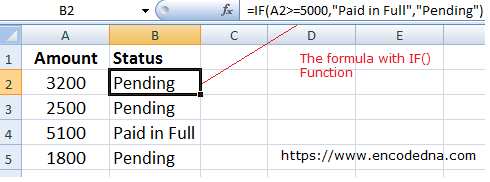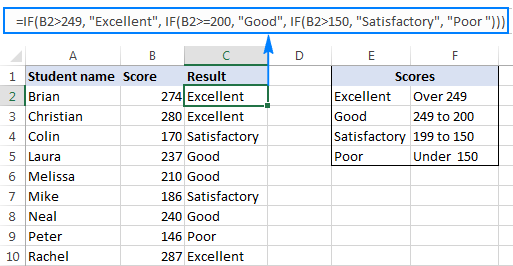The 4-Minute Rule for Excel If Then Statements
The feature tells the spread sheet the kind of formula. If a mathematics feature is being carried out, the math formula is bordered in parentheses. Making use of the range of cells for a formula. For example, A 1: A 10 is cells A 1 via A 10. Formulas are developed making use of outright cell referral.

In our very first formula participated in the cell "D 1," we by hand get in a =amount formula to include 1 +2 (in cells A 1 and B 2) to get the total of "3." With the next instance, we make use of the highlight cells A 2 to D 2 and afterwards rather than keying the formula use the formula button in Excel to instantly develop the formula.
Lastly, we by hand enter a times (*) formula making use of sum feature to locate the value of 5 * 100. Note The functions listed here might not be the very same in all languages of Microsoft Excel. All these instances are done in the English version of Microsoft Excel. Suggestion The instances listed below are detailed in indexed order, if you intend to start with one of the most usual formula, we suggest starting with the =AMOUNT formula.

=STANDARD(X: X) Show the ordinary quantity in between cells. For instance, if you wished to obtain the average for cells A 1 to A 30, you would type: =STANDARD(A 1: A 30). =MATTER(X: X) =COUNTA(X: X) Count the number of cells in a variety which contain any type of text (text and numbers, not just numbers) as well as are not empty.
4 Simple Techniques For Excel If Then
If 7 cells were empty, the number "13" would certainly be returned. =COUNTIF(X: X,"*") Count the cells that have a particular value. As an example, if you have =COUNTIF(A 1: A 10,"EXAMINATION") in cell A 11, after that any cell between A 1 via A 10 that has the word "test" will certainly be counted as one.
As an example, the formula =IF(A 1="","BLANK","NOT SPACE") makes any cell besides A 1 state "SPACE" if A 1 had nothing within it. If A 1 is not vacant, the other cells will read "NOT BLANK". The IF declaration has more intricate uses, however can usually be minimized to the above framework.
For example, you might be dividing the values between two cells. Nonetheless, if there is absolutely nothing in the cells you would obtain the =INDIRECT("A"&"2") Returns a referral specified by a message string. In the above instance, the formula would return the value of the cell consisted of in A 2.
=AVERAGE(A 1: A 7) Find the mean of the values of cells A 1 through A 7. For instance, 4 is the typical for 1, 2, 3, 4, 5, 6, 7. =MIN/MAX(X: X) Min as well as Max stand for the minimum or maximum quantity in the cells. For instance, if you intended to get the minimum worth between cells A 1 and also A 30 you would put =MINUTES(A 1: A 30) or if you wanted to get the maximum regarding =MAX(A 1: A 30).
Some Of Excel If And
As an example, =Item(A 1: A 30) would several all cells together, so A 1 * A 2 * A 3, etc. =RAND() Produces an arbitrary number more than zero however much less than one. For instance, "0.681359187" can be a randomly produced number put right into the cell of the formula. =RANDBETWEEN(1,100) Produce an arbitrary number between two values.
=ROUND(X, Y) Round a number to a specific variety of decimal areas. X is the Excel cell consisting of the number to be rounded. Y is the variety of decimal areas to round. Below are some examples. =ROUND(A 2,2) Beats the number in cell A 2 to one decimal area. If the number is 4.7369, the above example would round that number to 4.74.
=ROUND(A 2,0) Rounds the number in cell A 2 to zero decimal places, or the nearest whole number. If the number is 4.736, the above instance would certainly round that number to 5. If the number is 4.367, it would certainly round to 4. =AMOUNT(X: X) The most commonly utilized feature to add, subtract, several, or divide values in cells.
=AMOUNT(A 1+A 2) Include the cells A 1 and A 2. =SUM(A 1: A 5) Add cells A 1 with A 5. =AMOUNT(A 1, A 2, A 5) Includes cells A 1, A 2, and also A 5. =AMOUNT(A 2-A 1) Subtract cell A 1 from A 2. =AMOUNT(A 1 * A 2) Multiply cells A 1 and A 2.

8 Easy Facts About Excel If Blank Shown
=SUMIF(X: X,"*"X: X) Execute the SUM feature only if there is a defined value in the initial chosen cells. An example of this would certainly be =SUMIF(A 1: A 6,"TEST", B 1: B 6) which just adds the worths B 1: B 6 if the word "examination" was placed someplace in between A 1: A 6. So if you put EXAMINATION (not case sensitive) in A 1, however had numbers in B 1 with B 6, it would just add the value in B 1 since TEST remains in A 1.

=TODAY() Would certainly publish out the current day in the cell entered. The worth will certainly transform each time you open your spreadsheet, to show the present date and time. If you intend to enter a day that does not alter, hold back semicolon) to go into the date. =TREND(X: X) To locate the typical value of cell.
=VLOOKUP(X, X: X, X, X) The lookup, hlookup, or vlookup formula allows you to look as well as find relevant worths for returned results. See our lookup definition for a complete definition and also complete details on this formula. .
Each IF function in an Excel spread sheet returns one of two messages. The very first-- the "if" message-- displays if cells fulfill standards that you specify. The second-- the "otherwise" message-- displays if they do not. As an example, expect that your sheet tracks the hours that each of your employees jobs.
excel formula if cell has value excel if formula based on color formula excel if not